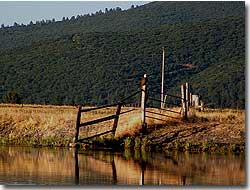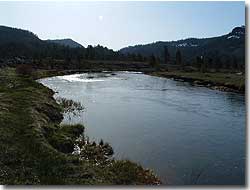“A blind man in the dark room-
Looking for a black hat - which isn’t there.”
Lord Bowen 1835-1894 I must confess to having endured this fly fisher malady caused by staring into the hypnotic lower depths of mesmerizing rivers, streams, creeks, lakes, mud holes and puddles thought to be home to game fish. Perhaps no other condition known to mankind can suddenly cause grown men and small boys let alone the woman folk to become almost comatose with the tell tale 500 yard stare and glassed over hypnotic trance like posture very much like that of shore birds standing still waiting for movement denoting dinner.( Deep Nymph-a-mania spelled with an a not an o.)
 At the tender age of around seven my uncle Dan the real cowboy in the family witnessed my not moving or turning my head fixated on several trout underneath the tree branch I was laying on, first seeds sown. This onset became much worse after years spent staring at moving water as if I had eye sight like Spiderman and could actually see that nymph or emerger fly many feet under water. Those fly fisher next of kin who see the above symptoms try to calmly move the patient ( fixated fly-fisher) slowly toward his or her favorite chair and provide latest fly fishing brochures or the fly tying table might help to bring them back? Speak slowly and say things like, “ Lets get your favorite Bamboo rod out and relive some great mornings ok big guy ( or little gal )!”
At the tender age of around seven my uncle Dan the real cowboy in the family witnessed my not moving or turning my head fixated on several trout underneath the tree branch I was laying on, first seeds sown. This onset became much worse after years spent staring at moving water as if I had eye sight like Spiderman and could actually see that nymph or emerger fly many feet under water. Those fly fisher next of kin who see the above symptoms try to calmly move the patient ( fixated fly-fisher) slowly toward his or her favorite chair and provide latest fly fishing brochures or the fly tying table might help to bring them back? Speak slowly and say things like, “ Lets get your favorite Bamboo rod out and relive some great mornings ok big guy ( or little gal )!”
 Those fly fishers who only work nymphs deep understand how difficult it is to begin to have an instinct or good eyes that never leave the strike indicator. I have known men who never used strike indicators and did land fine fish without bright yarn balls suddenly moving fast indicating a fish has hit the fly. Deep nymph work means learning to instinctively feel the slightest movement or detect the line jerking out suddenly. Many schools of thought exist on how exactly to work deep flies and not loose opportunities because hits are missed.
Those fly fishers who only work nymphs deep understand how difficult it is to begin to have an instinct or good eyes that never leave the strike indicator. I have known men who never used strike indicators and did land fine fish without bright yarn balls suddenly moving fast indicating a fish has hit the fly. Deep nymph work means learning to instinctively feel the slightest movement or detect the line jerking out suddenly. Many schools of thought exist on how exactly to work deep flies and not loose opportunities because hits are missed.
SLACK LINE SLIGHT OF HAND
Keep your slack line under control not taking in so much line you are effecting a dead drift or letting too much slack line take you out of the game because you cannot feel or see hits, a happy medium is nirvana? Where you fly fish is always the key of course, fast water or slow, stream or lake, early or late season are only a few of your considerations. If your still losing fish maybe your tippet is too light use a # 5 or #6 weight instead? Still not getting any hits or bumps, try another size smaller fly or begin more carefully working each section of the water your in. Many novice deep nymphers fail to understand how many missed fish occur because they are not changing either depth or retrieval routines. If you concentrate on covering ALL existent areas within casting distance always from afar moving toward you, leaving no water shadows or casting any profiles of you on the water your luck may suddenly change.
Learning to see in a dark room or under dark fast water really translates via the fly fisher secret decoder to complete understanding of what a three pound fish will do to your heart and wrist without any warning other then a slight movement of your strike indicator. Learning to keep making adjustments to water depth, speed, kinds of common local insects and more important where to throw to holding fish. Most game fish like to linger in either deep holes where currents above move food their way, behind large rocks or under big trees. One must spend time sitting and studying where fish feed and rest to understand how to fly fish successfully.
NYMPHOLOGY 101
1.) Master knowing exactly what depth your nymph, emerger is going to be moving at? If this is difficult practice with measuring from the place you tie your strike indicator down to the bottom of your ( clear ) practice water. Then tie on a weight instead of a fly and practice feeling and actually watching your surface line react to the weight scrapping along the bottom. With practice you will begin to understand how to intuit the fish hitting your fly from surface waves or current tension, A simple but effective learning exercise even for journeymen fly fishers needing to retune.
2.) Learn which of the known strike indicators works for you and what color, many people use yarn that is treated with floatant or tiny plastic contraptions plus new strike indicators that seem to appear almost monthly. The idea is you need to establish real trust and learn exactly how to rig your new true deep nymphing tool. This is another aspect that can be practiced before actually depending on something that is an unknown. Buy three different style strike indicators and spend time trying each one in water you fly fish in, confidence is the complete fly fishers true companion and simplicity...
3.) Retrieval methods versus dead drifting is a classic nymph fly fisher riddle that is always open for debate. I have caught as many big fish or more using any of the many pause and twitch or pause and strip quickly techniques that are simple to learn. If your dead drift is not effective after ten drifts, try at first small quick movements every ten feet and then very by letting the fly drift counting to twenty and then twitching or strip it hard and wait another five seconds and so on and very this cadence every cast. This at times can change your day and put you on fish, don’t be afraid to experiment while working any deep fly of any kind, in fact don’t be afraid to experiment with any aspect of fly fishing is the best advise.
4.) The visibility of your tippet or final line tied to your fly is of absolute consideration all the time not just in clear water. If you use at least a #6 weight for trout and if necessary go down to #7 if no fish are hitting and see if that helps. If you go any lighter then #7 weight ( two pound test ) your looking to loose big fish, take several strips of different weight tippets and hold them under fast moving stream, creek and you will understand which are more effective.If you early on establish the habit of pretesting all your fly fishing gear before working fly waters, many stream side fowl ups can be avoided grasshopper!
5.) If you begin to try and imagine exactly where big fish might be holding as in their usual haunts, its not the biggest mystery on the planet where big fish hold to feed or save energy. They usually can be found in deep water that has fast current near by or over head to bring a constant stream of possible bug offerings their way.
Under or just next to large boulders or bends in the stream or almost any where along the water edge in undercuts you can’t see or under large trees is usually home to fish. If you begin by studying where the water currents meet after colliding and slowing just a little, that is where many fish are waiting for insects, nymphs.
 Click Here for this month's story line of
Click Here for this month's story line of
“ ADVENTURES OF FLETCHER QUILL “
